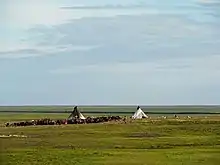Pastoralism
Pastoralism is a form of animal husbandry where domesticated animals known as livestock are released onto large vegetated outdoor lands (pastures) for grazing, historically by nomadic people who moved around with their herds. The species involved include cattle, camels, goats, yaks, llamas, reindeer, horse and sheep.[1]
| Part of a series on |
| Economic, applied, and development anthropology |
|---|
| Social and cultural anthropology |
.jpg.webp)
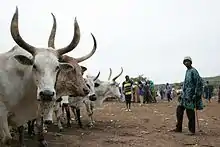
Pastoralism is found in many variations throughout the world, generally where environmental characteristics such as aridity, poor soils, cold or hot temperature, and lack of water make crop growing difficult or impossible. Operating in these more extreme environments with more marginal lands, mean that pastoral communities are very vulnerable to global warming.[2]
Pastoralism remains a way of life in many geographies including Africa, the Tibetan plateau, the Eurasian steppes, the Andes, Patagonia, the Pampas, Australia and many other places. As of 2019, 200-500 million people practise pastoralism globally, and 75% of all countries have pastoral communities.[2]
Pastoral communities have different levels of mobility. Sedentary pastoralism is becoming more common as the hardening of political borders, land tenures, expansion of crop farming, and construction of fences and dedicated agricultural buildings all reduce the ability to move livestocks around freely, leading to the rise of pastoral farming on established grazing zones called ranches. Sedentary pastoralists might also raise crops and livestocks together in the form of mixed farming, for the purpose of diversifying productivity, obtaining manure for organic farming, and improve pasture conditions for their livestock. Mobile pastoralism includes moving herds locally across short distances in search of fresh forage and water, something that can occur daily or even within a few hours; to transhumance, where animals are routinely moved between different seasonal pastures across regions; to nomadism, where pastoralists and families move with the animals in search for any available grazing grounds without much long-term planning. Grazing in woodlands and forests may be referred to as silvopastoralism.[3]
Pastoralist herds interact with their environment, and mediate human relations with the environment as a way of turning uncultivated plants like wild grass into food. In many places, grazing herds on savannas and woodlands can help maintain the biodiversity of the savannas and prevent them from evolving into dense shrublands or forests. Grazing and browsing at the appropriate levels often can increase biodiversity in Mediterranean climate regions.[4][5] Pastoralists shape ecosystems in different ways: some communities use fire to make ecosystems more suitable for grazing and browsing animals.
Origins
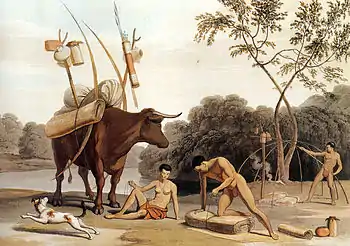
One theory is that pastoralism was created from mixed farming. Bates and Lees proposed that it was the incorporation of irrigation into farming which ensued in specialization.[6] Advantages of mixed farming include reducing risk of failure, spreading labour, and re-utilizing resources. The importance of these advantages and disadvantages to different farmers differs according to the sociocultural preferences of the farmers and the biophysical conditions as determined by rainfall, radiation, soil type, and disease.[7] The increased productivity of irrigation agriculture led to an increase in population and an added impact on resources. Bordering areas of land remained in use for animal breeding. This meant that large distances had to be covered by herds to collect sufficient forage. Specialization occurred as a result of the increasing importance of both intensive agriculture and pastoralism. Both agriculture and pastoralism developed alongside each other, with continuous interactions.[6]
There is another theory that suggests pastoralism evolved from hunting and gathering. Hunters of wild goats and sheep were knowledgeable about herd mobility and the needs of the animals. Such hunters were mobile and followed the herds on their seasonal rounds. Undomesticated herds were chosen to become more controllable for the proto-pastoralist nomadic hunter and gatherer groups by taming and domesticating them. Hunter-gatherers' strategies in the past have been very diverse and contingent upon the local environment conditions, like those of mixed farmers. Foraging strategies have included hunting or trapping big game and smaller animals, fishing, collecting shellfish or insects, and gathering wild plant foods such as fruits, seeds, and nuts.[8] These diverse strategies for survival amongst the migratory herds could also provide an evolutionary route towards nomadic pastoralism.
Resources
Pastoralism occurs in uncultivated areas. Wild animals eat the forage from the marginal lands and humans survive from milk, blood, and often meat of the herds and often trade by-products like wool and milk for money and food.[9]
Pastoralists do not exist at basic subsistence. Pastoralists often compile wealth and participate in international trade. Pastoralists have trade relations with agriculturalists, horticulturalists, and other groups. Pastoralists are not extensively dependent on milk, blood, and meat of their herd. McCabe noted that when common property institutions are created, in long-lived communities, resource sustainability is much higher, which is evident in the East African grasslands of pastoralist populations.[10] However, it needs to be noted that the property rights structure is only one of the many different parameters that affect the sustainability of resources, and common or private property per se, does not necessarily lead to sustainability.[11]
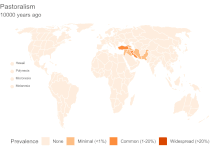
Some pastoralists supplement herding with hunting and gathering, fishing and/or small-scale farming or pastoral farming.
Mobility
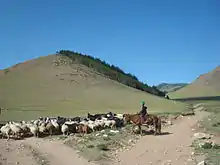
Mobility allows pastoralists to adapt to the environment, which opens up the possibility for both fertile and infertile regions to support human existence. Important components of pastoralism include low population density, mobility, vitality, and intricate information systems. The system is transformed to fit the environment rather than adjusting the environment to support the "food production system."[13] Mobile pastoralists can often cover a radius of a hundred to five hundred kilometers.
Pastoralists and their livestock have impacted the environment. Lands long used for pastoralism have transformed under the forces of grazing livestock and anthropogenic fire. Fire was a method of revitalizing pastureland and preventing forest regrowth. The collective environmental weights of fire and livestock browsing have transformed landscapes in many parts of the world. Fire has permitted pastoralists to tend the land for their livestock. Political boundaries are based on environmental boundaries.[14] The Maquis shrublands of the Mediterranean region are dominated by pyrophytic plants that thrive under conditions of anthropogenic fire and livestock grazing.[15]
Nomadic pastoralists have a global food-producing strategy depending on the management of herd animals for meat, skin, wool, milk, blood, manure, and transport. Nomadic pastoralism is practiced in different climates and environments with daily movement and seasonal migration. Pastoralists are among the most flexible populations. Pastoralist societies have had field armed men protect their livestock and their people and then to return into a disorganized pattern of foraging. The products of the herd animals are the most important resources, although the use of other resources, including domesticated and wild plants, hunted animals, and goods accessible in a market economy are not excluded. The boundaries between states impact the viability of subsistence and trade relations with cultivators.[16]
Pastoralist strategies typify effective adaptation to the environment.[17] Precipitation differences are evaluated by pastoralists. In East Africa, different animals are taken to specific regions throughout the year that corresponds to the seasonal patterns of precipitation.[18] Transhumance is the seasonal migration of livestock and pastoralists between higher and lower pastures.
Some pastoralists are constantly moving, which may put them at odds with sedentary people of towns and cities. The resulting conflicts can result in war for disputed lands. These disputes are recorded in ancient times in the Middle East, as well as for East Asia.[19][20] Other pastoralists are able to remain in the same location which results in longer-standing housing.
.jpg.webp)
Different mobility patterns can be observed: Somali pastoralists keep their animals in one of the harshest environments but they have evolved of the centuries. Somalis have well developed pastoral culture where complete system of life and governance has been refined. Somali poetry depicts humans interactions, pastoral animals, beasts on the prowl, and other natural things such the rain, celestial events and historic events of significance. Wise sage Guled Haji coined a proverb that encapsulates the centrality of water in pastoral life
Ceel biyo lihi ma foga |
A well which has water is never far |
| —Guled Haji[21] |
Mobility was an important strategy for the Ariaal; however with the loss of grazing land impacted by the growth in population, severe drought, the expansion of agriculture, and the expansion of commercial ranches and game parks, mobility was lost. The poorest families were driven out of pastoralism and into towns to take jobs. Few Ariaal families benefited from education, healthcare, and income earning.[22]
The flexibility of pastoralists to respond to environmental change was reduced by colonization. For example, mobility was limited in the Sahel region of Africa with settlement being encouraged. The population tripled and sanitation and medical treatment were improved.
The Afar pastoralists in Ethiopia uses an indigenous communication method called dagu for information. This helps them in getting crucial information about climate and availability of pastures at various locations.
Information
Pastoralists have mental maps of the value of specific environments at different times of year. Pastoralists have an understanding of ecological processes and the environment.[23] Information sharing is vital for creating knowledge through the networks of linked societies.[24]
Pastoralists produce food in the world's harshest environments, and pastoral production supports the livelihoods of rural populations on almost half of the world's land. Several hundred million people are pastoralists, mostly in Africa and Asia. ReliefWeb reported that "Several hundred million people practice pastoralism—the use of extensive grazing on rangelands for livestock production, in over 100 countries worldwide. The African Union estimated that Africa has about 268 million pastoralists—over a quarter of the total population—living on about 43 percent of the continent’s total land mass."[25] Pastoralists manage rangelands covering about a third of the Earth's terrestrial surface and are able to produce food where crop production is not possible.
Pastoralism has been shown, "based on a review of many studies, to be between 2 and 10 times more productive per unit of land than the capital intensive alternatives that have been put forward". However, many of these benefits go unmeasured and are frequently squandered by policies and investments that seek to replace pastoralism with more capital intensive modes of production.[26] They have traditionally suffered from poor understanding, marginalization and exclusion from dialogue. The Pastoralist Knowledge Hub, managed by the Food and Agriculture Organization of the UN serves as a knowledge repository on technical excellence on pastoralism as well as "a neutral forum for exchange and alliance building among pastoralists and stakeholders working on pastoralist issues".[27]
Pastoralism and farm animal genetic resource
There is a variation in genetic makeup of the farm animals driven mainly by natural and human based selection.[28] For example, pastoralists in large parts of Sub Saharan Africa are preferring livestock breeds which are adapted to their environment and able to tolerate drought and diseases.[29] However, in other animal production systems these breeds are discouraged and more productive exotic ones are favored.[28] This situation could not be left unaddressed due to the changes in market preferences and climate all over the world,[30] which could lead to changes in livestock diseases occurrence and decline forage quality and availability. Hence pastoralists can maintain farm animal genetic resources by conserving local livestock breeds.[29] Generally conserving farm animal genetic resources under pastoralism is advantageous in terms of reliability and associated cost.[31]
Tragedy of the commons
Hardin's Tragedy of the Commons (1968) described how common property resources, such as the land shared by pastoralists, eventually become overused and ruined.[32] According to Hardin's paper, the pastoralist land use strategy suffered criticisms of being unstable and a cause of environmental degradation.[33]

However, one of Hardin's conditions for a "tragedy of the commons" is that people cannot communicate with each other or make agreements and contracts. Many scholars have pointed out that this is ridiculous, and yet it is applied in development projects around the globe, motivating the destruction of community and other governance systems that have managed sustainable pastoral systems for thousands of years. The outcomes have often been disastrous.[34] In her book Governing the Commons, Elinor Ostrom showed that communities were not trapped and helpless amid diminishing commons. She argued that a Common-pool resource, such as grazing lands used for pastoralism, can be managed more sustainably through community groups and cooperatives than through privatization or total governmental control.[35] Ostrom was awarded a Nobel Memorial Prize in Economic Sciences for her work.[36]
Pastoralists in the Sahel zone in Africa were held responsible for the depletion of resources.[33] The depletion of resources was actually triggered by a prior interference and punitive climate conditions.[37] Hardin's paper suggests a solution to the problems, offering a coherent basis for privatization of land, which stimulates the transfer of land from tribal peoples to the state or to individuals.[32] The privatized programs impact the livelihood of the pastoralist societies while weakening the environment.[23] Settlement programs often serve the needs of the state in reducing the autonomy and livelihoods of pastoral people.
The violent herder–farmer conflicts in Nigeria, Mali, Sudan, Ethiopia and other countries in the Sahel and Horn of Africa regions have been exacerbated by climate change, land degradation, and population growth.[38][39][40]
However, recently it has been shown that pastoralism supports human existence in harsh environments and often represents a sustainable approach to land use.[23]
See also
- Animal Genetic Resources for Food and Agriculture
- Herding
- Holistic management
- Pastoral society
- Pastoral (or bucolic) - related genre of literature, art, and music
References
- Schoof, Nicolas; Luick, Rainer (2018-11-29). "Ecology". doi:10.1093/obo/9780199830060-0207. ISBN 9780199830060. Cite journal requires
|journal=(help);|chapter=ignored (help) - Mbow, C.; Rosenzweig, C.; Barioni, L. G.; Benton, T.; et al. (2019). "Chapter 5: Food Security" (PDF). IPCC SRCCL 2019. pp. 439–442.
- Plieninger, Tobias; Huntsinger, Lynn (2018). "Complex Rangeland Systems: Integrated Social-Ecological Approaches to Silvopastoralism". Rangeland Ecology and Management. 71 (6): 519–525. doi:10.1016/j.rama.2018.05.002. S2CID 90123890.
- Perevolotovsky, A.; Seligman, N.G. (1998). "The role of grazing in Mediterranean rangeland ecosystems – inversion of a paradigm". BioScience. 48 (12): 1007–1017. doi:10.2307/1313457. JSTOR 1313457.
- Huntsinger, Lynn; Oviedo, Jose (2014). "Ecosystem Services are Social–ecological Services in a Traditional Pastoral System: the Case of California's Mediterranean Rangelands" (PDF). Rangeland Ecology and Management. 19 (1): 8. doi:10.5751/ES-06143-190108.
- Lees, Susan H.; Bates, Daniel G. (1974). "The Origins of Specialized Nomadic Pastoralism: A Systemic Model". American Antiquity. 39 (2): 187–193. doi:10.2307/279581. JSTOR 279581.
- "Mixed crop-livestock farming".
- "Hunting and Gathering Culture". Encyclopædia Britannica.
- Bates, 1998:105
- Moran, Emilio F. (2006). People and nature : an introduction to human ecological relations. Malden, MA: Blackwell Publishing. p. 123. ISBN 978-1-4051-0572-9.
- Ho, Peter (2000). "China's Rangelands under Stress: A Comparative Study of Pasture Commons in the Ningxia Hui Autonomous Region". Development and Change. 31 (2): 385–412. doi:10.1111/1467-7660.00159. ISSN 1467-7660.
- Stephens, Lucas; Fuller, Dorian; Boivin, Nicole; Rick, Torben; Gauthier, Nicolas; Kay, Andrea; Marwick, Ben; Armstrong, Chelsey Geralda; Barton, C. Michael (2019-08-30). "Archaeological assessment reveals Earth's early transformation through land use". Science. 365 (6456): 897–902. Bibcode:2019Sci...365..897S. doi:10.1126/science.aax1192. hdl:10150/634688. ISSN 0036-8075. PMID 31467217. S2CID 201674203.
- (Bates, 1998:104)
- Moran, Emilio F. (2006). People and Nature: An Introduction to Human Ecological Relations. Malden, MA: Blackwell Publishing. ISBN 978-1-4051-0572-9.
- Pyne, Stephen J. (1997) Vestal Fire: An Environmental History, Told through Fire, of Europe and Europe's Encounter with the World. Seattle and London: University of Washington Press. ISBN 0-295-97596-2
- Moran, Emilio F. (2006). People and Nature: An Introduction to Human Ecological Relations. Malden, MA: Blackwell Publishing. pp. 51–52. ISBN 978-1-4051-0571-2.
- Fagan, B. (1999) "Drought Follows the Plow", Chapter 11 of Floods, Famines and Emperors: Basic Books.
- Giulio Angioni (1989) I pascoli erranti: Liguori
- Ho, Peter (2000). "The Myth of Desertification at China's Northwestern Frontier: The Case of Ningxia Province, 1929–1958". Modern China. 26 (3): 348–395. doi:10.1177/009770040002600304. ISSN 0097-7004. S2CID 83080752.
- Ho, Peter (2003). "Mao's War against Nature? The Environmental Impact of the Grain-First Campaign in China". The China Journal. 50 (50): 37–59. doi:10.2307/3182245. ISSN 1324-9347. JSTOR 3182245. S2CID 144410824.
- Andrzejewski, B.W (1978). "Accentual Patterns in Verbal Forms in the Isaaq dialect of Somali". Bulletin of the School of Oriental and African Studies, University of London. Vol 18 (1): 103–129.
- Townsend, Patricia K. (2009). Environmental Anthropology: From Pigs to Policies. United States: Waveland Press. pp. 57–58. ISBN 978-1-57766-581-6.
- Wilson, K. B. (1992). "Re-Thinking the Pastoral Ecological Impact in East Africa". Global Ecology and Biogeography Letters. 2 (4): 143–144. doi:10.2307/2997644. JSTOR 2997644.
- Roe, Emery; Huntsinger, Lynn; Labnow, Keth (1998). "High reliability versus risk averse pastoralism". Environment and Development. 7 (Dec): 387–399. doi:10.1177/107049659800700404. S2CID 154351769.
- "Farmer-Herder Conflicts on the Rise in Africa". ReliefWeb. 6 August 2018.
- McGahey, D.; Davies, J.; Hagelberg, N.; Ouedraogo, R. (2014). Pastoralism and the Green Economy –a natural nexus?. Nairobi: IUCN and UNEP. pp. x+58. ISBN 978-2-8317-1689-3.
- FAO, 2016. The Pastoralist Knowledge Hub. http://www.fao.org/pastoralist-knowledge-hub/background/why-a-hub/en/ retrieved Nov. 2016
- Wollny, Clemens B.A (2003). "The need to conserve farm animal genetic resources in Africa: should policy makers be concerned?". Ecological Economics. 45 (3): 341–351. doi:10.1016/s0921-8009(03)00089-2.
- Zander, K.K.; Drucker, A.G.; Holm-Müller, K. (2009). "Costing the conservation of animal genetic resources: The case of Borana cattle in Ethiopia and Kenya". Journal of Arid Environments. 73 (4–5): 550–556. Bibcode:2009JArEn..73..550Z. doi:10.1016/j.jaridenv.2008.11.003.
- J., Philipsson; Ally, Okeyo Mwai (2006). "Global perspectives on animal genetic resources for sustainable agriculture and food production in the tropics". hdl:10568/3665. Cite journal requires
|journal=(help) - Paiva, Samuel Rezende; McManus, Concepta M.; Blackburn, Harvey (2016). "Conservation of animal genetic resources – A new tact". Livestock Science. 193: 32–38. doi:10.1016/j.livsci.2016.09.010.
- Hardin, Garrett (1968). "The Tragedy of the Commons". Science. 162 (3859): 1243–1248. Bibcode:1968Sci...162.1243H. doi:10.1126/science.162.3859.1243. PMID 17756331.
- Fratkin, Elliot (1997). "Pastoralism: Governance and Development Issues". Annual Review of Anthropology. 26: 235–261. doi:10.1146/annurev.anthro.26.1.235.
- Li, Wenjun; Huntsinger, Lynn (2011). "China's Grassland Contract Policy and its Impacts on Herder Ability to Benefit in Inner Mongolia: Tragic Feedbacks". Ecology and Society. 16 (2): 8. doi:10.5751/ES-03969-160201.
- Ostrom, Elinor (1990). Governing the Commons: The Evolution of Institutions for Collective Action. Cambridge University Press. ISBN 978-0-521-40599-7.
- "Nobel Prize Awarded Women". Retrieved 14 October 2019.
- Ho, P. (2001). "Rangeland Degradation in North China Revisited? A Preliminary Statistical Analysis to Validate Non-Equilibrium Range Ecology". The Journal of Development Studies. 37 (3): 99–133. doi:10.1080/00220380412331321991. ISSN 0022-0388. S2CID 154397243.
- "How Climate Change Is Spurring Land Conflict in Nigeria". Time. 28 June 2018.
- "The battle on the frontline of climate change in Mali". BBC News. 22 January 2019.
- "The Deadliest Conflict You've Never Heard of". Foreign Affairs. 23 January 2019.
Bibliography
- Fagan, B. (1999). "Drought Follows the Plow", adapted from Floods, Famines and Emperors: Basic Books.
- Fratkin, E. (1997). "Pastoralism: Governance & Development Issues". Annual Review of Anthropology, 26: 235–261.
- Hardin, G. (1968). “The Tragedy of the Commons". Science, 162(3859), 1243–1248.
- Angioni, Giulio (1989). I pascoli erranti. Antropologia del pastore in Sardegna. Napoli, Liguori. ISBN 978-8820718619.
- Hole, F. (1996). "The context of caprine domestication in the Zagros region'". in The Origins and Spread of Agriculture and Pastoralism in Eurasia. D.R. Harris (ed.). London, University College of London: 263–281.
- Lees, S & Bates, D. (1974). "The Origins of Specialized Nomadic Pastoralism: A Systematic Model". American Antiquity, 39, 2.
- Levy, T.E. (1983). "Emergence of specialized pastoralism in the Levant". World Archaeology 15(1): 15–37.
- Moran, E. (2006). People and Nature: An Introduction to Human Ecological Relations. UK: Blackwell Publishing.
- Pyne, Stephen J. (1997). Vestal Fire: An Environmental History, Told through Fire, of Europe and Europe's Encounter with the World. Seattle and London: University of Washington Press. ISBN 0-295-97596-2.
- Townsend, P. (2009). Environmental Anthropology: From Pigs to Policies. United States of America: Waveland Press.
- Wilson, K.B. (1992). "Re-Thinking the Pastoral Ecological Impact in East Africa". Global Ecology and Biogeography Letters, 2(4): 143–144.
- Toutain B., Marty A., Bourgeot A. Ickowicz A. & Lhoste P. (2012). Pastoralism in dryland areas. A case study in sub-Saharan Africa. Les dossiers thématiques du CSFD. N°9. January 2013. CSFD/Agropolis International, Montpellier, France. 60 p.
